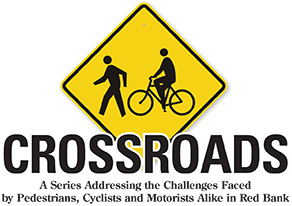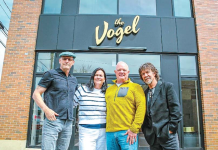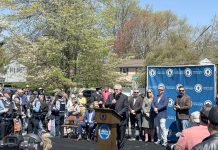Seattle, Washington and Portland, Oregon know how to make their streets safer for pedestrians and cyclists.
Both cities, have large and increasing numbers of those who look to walk, peddle and use mass transit to get around and long term plans are geared to encourage that evolution.
“When people walk, bike, take mass transit to meet their daily needs it means they’re healthier, they arrive at work happier, more energized and it means they get to know their neighborhoods, their surroundings,” noted Dylan Rivera, public information officer for the Portland Bureau of Transportation.
“For us this is something that we’ve been working on for decades and have made great strides,” in protecting the public, especially those walking and peddling, added James Curtin, Seattle’s director of public safety.
The officials noted that some initiatives put in place over the years have actually resulted in significant reductions of serious accidents and fatalities.
Curtin had data immediately available, noting that in 2007 there were a total of 14,971 police reported collisions and by 2013 that number had dropped to 10,310. For fatalities, Seattle had an average of 30 to 40 traffic fatalities a year – with “pedestrians most at risk, older pedestrians especially,” Curtin said, noting that is still true. But in 2014 that number had dropped to 14.
By the middle of the 20th century large urban areas and their surrounding suburbs were being developed to accommodate more vehicular traffic rather than taking pedestrians into consideration, they said. “Like nobody was ever going to walk anywhere again,” was how Rivera characterized it.
By the 1970s the thinking had begun to change, with officials giving some thought to how all of the population’s needs can be met safely.
Portland has had for the last 10 years the largest bike commute rate of any major U.S. city, according to Rivera. “Now with communities and people revitalizing their downtowns and main streets,” Rivera observed, “they want people to walk and not have to rely on their cars to get around.”
Portland, for instance, has more than 300 miles of bike paths, including on most of the city’s bridges, which see about 17,000-bicycle trips daily.
Portland has also been installing what it calls bike boxes at the front of traffic intersections. It’s a colored designated area for cyclists to move to the front of the intersection, with vehicles queued behind the bikes and prevented from making right turns on red until the bikes proceed. “It adds visibility to the cyclists,” Rivera said, adding, “That’s been a very effective tool.”
Portland officials have been reconfiguring major roadways, those with four lanes, reducing them to three, including a center lane left turn lane – what’s called “road diets” – that have improved safety for motorists and pedestrians, with studies showing that this one measure can reduce collisions by 40 percent, according to Rivera.
The city has also installed more pedestrian-activated flashing lights at an increasing number of intersections.
Seattle has been installing actual dividers separating bike paths from vehicular traffic for added safety, according to Curtin.
For those walking, Seattle has islands separating wide thoroughfares, giving pedestrians a place to safely wait if they can’t cross in the designated time, Curtin said.
The “road diets” have led to decreased motorist speeding. The city has adopted a policy of not putting striped crosswalks at three or more lane intersections without traffic lights, hoping to encourage pedestrians to cross at traffic signals, Curtin said.
Like New York City and other major cities, Seattle has adopted a “Vision Zero” agenda to completely eliminate traffic/pedestrian fatalities, that is “really, really aggressive,” Curtin said.
A major part of that plan involves reducing the speed limit through much of the city. “We know there is a direct relationship between speed of vehicles and survival, especially for pedestrians,” he said.
Enforcement is another factor, Curtin added, with an aggressive campaign scheduled to begin at the end of April.
So far camera-monitored traffic law enforcement for school zones – with fines going directly for education purposes – has been very effective, Curtin added.
Portland has adopted a program where business owners can ask vehicle parking spaces be turned into bicycle parking. “We have a waiting list of dozens of businesses raising their hands, saying ‘I want one too,’” Rivera noted.
Next on the agenda for Portland is looking at 10 particularly troublesome intersections, some with high fatality counts. City officials have reached out to business associations and neighborhood groups (who were all too ready to offer input) on what might be done to improve those sites, Rivera said. And while money can be tight, officials are looking at “short term, inexpensive improvements,” that can be easily accomplished, such as restriping roadways and installing flashing beacons, he said.
Encouraging and protecting pedestrians isn’t just good public policy; it’s good economics for local businesses, Rivera stressed. “It’s helped our downtown businesses,” as residents are shopping more locally and has saved city residents about $2 million annually, in gas and vehicle maintenance costs, he said.
By John Burton
John Burton can be reached at 732-219-5788 or by jburton@tworivertimes.com.

More stories in the Two River Times Crossroads series:
Local Readers Offer Solutions (April 17 edition)
Hazardous Crosswalks: Ambulance Hits Pedestrian on Broad Street (April 3, 2015)
Hazardous Crosswalks: Walkers Share Collision Tales (Edition of April 3, 2015)
Fair Haven Cycling Safety on the Fast Track (Edition of April 3, 2015)
Editorial Opinion: Pedestrian Accident Urgent Reminder We Need Safer Street Crossings (Edition of April 3, 2015)
Safety Moving Forward in Red Bank (Edition of March 20, 2015)
Crossroads: Results of First Editorial Meeting About Pedestrian Safety in the Greater Red Bank Area (Edition of March 13, 2015)
Both cities, have large and increasing numbers of those who look to walk, peddle and use mass transit to get around and long term plans are geared to encourage that evolution.
“When people walk, bike, take mass transit to meet their daily needs it means they’re healthier, they arrive at work happier, more energized and it means they get to know their neighborhoods, their surroundings,” noted Dylan Rivera, public information officer for the Portland Bureau of Transportation.
“For us this is something that we’ve been working on for decades and have made great strides,” in protecting the public, especially those walking and peddling, added James Curtin, Seattle’s director of public safety.
The officials noted that some initiatives put in place over the years have actually resulted in significant reductions of serious accidents and fatalities.
Curtin had data immediately available, noting that in 2007 there were a total of 14,971 police reported collisions and by 2013 that number had dropped to 10,310. For fatalities, Seattle had an average of 30 to 40 traffic fatalities a year – with “pedestrians most at risk, older pedestrians especially,” Curtin said, noting that is still true. But in 2014 that number had dropped to 14.
By the middle of the 20th century large urban areas and their surrounding suburbs were being developed to accommodate more vehicular traffic rather than taking pedestrians into consideration, they said. “Like nobody was ever going to walk anywhere again,” was how Rivera characterized it.
By the 1970s the thinking had begun to change, with officials giving some thought to how all of the population’s needs can be met safely.
Portland has had for the last 10 years the largest bike commute rate of any major U.S. city, according to Rivera. “Now with communities and people revitalizing their downtowns and main streets,” Rivera observed, “they want people to walk and not have to rely on their cars to get around.”
Portland, for instance, has more than 300 miles of bike paths, including on most of the city’s bridges, which see about 17,000-bicycle trips daily.
Portland has also been installing what it calls bike boxes at the front of traffic intersections. It’s a colored designated area for cyclists to move to the front of the intersection, with vehicles queued behind the bikes and prevented from making right turns on red until the bikes proceed. “It adds visibility to the cyclists,” Rivera said, adding, “That’s been a very effective tool.”
Portland officials have been reconfiguring major roadways, those with four lanes, reducing them to three, including a center lane left turn lane – what’s called “road diets” – that have improved safety for motorists and pedestrians, with studies showing that this one measure can reduce collisions by 40 percent, according to Rivera.
The city has also installed more pedestrian-activated flashing lights at an increasing number of intersections.
Seattle has been installing actual dividers separating bike paths from vehicular traffic for added safety, according to Curtin.
For those walking, Seattle has islands separating wide thoroughfares, giving pedestrians a place to safely wait if they can’t cross in the designated time, Curtin said.
The “road diets” have led to decreased motorist speeding. The city has adopted a policy of not putting striped crosswalks at three or more lane intersections without traffic lights, hoping to encourage pedestrians to cross at traffic signals, Curtin said.
Like New York City and other major cities, Seattle has adopted a “Vision Zero” agenda to completely eliminate traffic/pedestrian fatalities, that is “really, really aggressive,” Curtin said.
A major part of that plan involves reducing the speed limit through much of the city. “We know there is a direct relationship between speed of vehicles and survival, especially for pedestrians,” he said.
Enforcement is another factor, Curtin added, with an aggressive campaign scheduled to begin at the end of April.
So far camera-monitored traffic law enforcement for school zones – with fines going directly for education purposes – has been very effective, Curtin added.
Portland has adopted a program where business owners can ask vehicle parking spaces be turned into bicycle parking. “We have a waiting list of dozens of businesses raising their hands, saying ‘I want one too,’” Rivera noted.
Next on the agenda for Portland is looking at 10 particularly troublesome intersections, some with high fatality counts. City officials have reached out to business associations and neighborhood groups (who were all too ready to offer input) on what might be done to improve those sites, Rivera said. And while money can be tight, officials are looking at “short term, inexpensive improvements,” that can be easily accomplished, such as restriping roadways and installing flashing beacons, he said.
Encouraging and protecting pedestrians isn’t just good public policy; it’s good economics for local businesses, Rivera stressed. “It’s helped our downtown businesses,” as residents are shopping more locally and has saved city residents about $2 million annually, in gas and vehicle maintenance costs, he said.
By John Burton
John Burton can be reached at 732-219-5788 or by jburton@tworivertimes.com.

More stories in the Two River Times Crossroads series:
Local Readers Offer Solutions (April 17 edition)
Hazardous Crosswalks: Ambulance Hits Pedestrian on Broad Street (April 3, 2015)
Hazardous Crosswalks: Walkers Share Collision Tales (Edition of April 3, 2015)
Fair Haven Cycling Safety on the Fast Track (Edition of April 3, 2015)
Editorial Opinion: Pedestrian Accident Urgent Reminder We Need Safer Street Crossings (Edition of April 3, 2015)
Safety Moving Forward in Red Bank (Edition of March 20, 2015)
Crossroads: Results of First Editorial Meeting About Pedestrian Safety in the Greater Red Bank Area (Edition of March 13, 2015)














